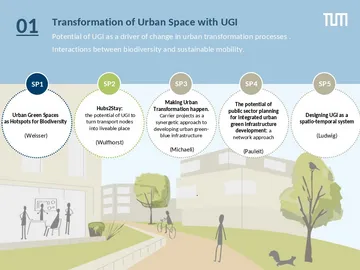Research Cluster 1: Transformation of Urban Space with UGI
Head: Mark Michaeli
The significance of urban environments for biodiversity is now widely recognized and integrative ways to retain and enhance biodiversity within cities are sought. However, many urban residents live in districts where only a few plant and animal species occur, and this makes people increasingly separated from nature in their daily life.
UGI provides opportunities where city dwellers can experience nature, and such experience also determines how humans perceive and value it. Moreover, biodiversity underlies many ESS demanded by humans, including direct effects on well-being and health. Therefore, urban ecological reconstruction to enhance biodiversity is wanted, particularly if it comes along with the rising quality of urban life, synergies with daily activities, and the related potential for sustainable urban mobility, such as walking and cycling.
Unfortunately, urban nature and UGI have been neglected as potential drivers of change in urban planning so far despite ambitious sustainability goals laid down in strategic urban development frameworks, and in the practice of urban transformation, the potential of UGI is far from being sufficiently tapped. This is often explained with lock-in effects caused by the self-stabilizing forces of the existing urban structures and their operational framework.
Thus, sustainability transition relies on socio-technical regime transformation, mirroring all three key dimensions of SET's. A systems analysis of the governance processes is needed to overcome the barriers to integrated planning and implementation of multifunctional UGI. Case-study research has revealed complex combinations of culture-, structure- and practice-led agencies as key success factors of long-term transformation.
Scenario research has explored the plausibility of promoting or prioritizing particular avenues (e.g., political vs. market-driven approach) in facilitating transformation and application of new solutions. We seek to augment systemic knowledge in the field by complementing the multi-disciplinary approach to SET transitions by shedding light on the nature of solutions to implement UGI with the three strategies of operationalization, substitution, and integration. Characteristics of solutions as well as processes of deployment and operation of UGI, including relevant governance modes and actor networks are scrutinized against the backdrop of contemporary practice in urban transformation projects.
The goal of Cluster 1
RC 1 aims to significantly enhance the process of transformation of the existing urban fabric and its elements towards a multifunctional UGI as a valuable resource in terms of biodiversity, sustainable urban mobility and reconstruction. The strategy of green-gray Integration is emphasized by the first two subprojects:
SP1 (Biodiversity) will study the potential of UGI for creating continuous and coherent elements of high value for biodiversity within the urban built fabric. Today, the majority of urban transformation projects focus on the element, not the network scale, thus the possibility for immediate intervention is often limited on large-scale infrastructure projects coming along e.g., with a substantial change of street layout, transportation technology and mobility behavior. Therefore, SP1 is closely interacting with SP2 (Mobility) to enhance the ecological functionality of the smart integration of UGI into the reconstruction of mobility spaces, and reciprocally upgrading these spaces as the spinal network of UGI.
Ensuing questions for UGI Operationalization are in the focus of SP3 (urban reconstruction) and SP4 (Gobernance). SP3 sheds light on the subsequent structural properties of the urban elements and networks and draws links to typical urban renewal and development projects and their qualification potential as catalysts of UGI implementation. It is expected, that this process can be facilitated with better knowledge of transformation regimes, which is systematically examined in SP4.
Finally, SP5 (Designing UGI) complements RC1 with the consideration of dynamic processes in UGI design, with links to SP1 and other research clusters (subprojects 6 (indoor-outdoor), 7 (microclimate) and 8 (Urban trees)). The novelty of the approach lies in the entanglement of structure and process, highlighting urban reconstruction and the transformative potential of UGI. The results of RC1 at different spatial scales will be considered as input for a common systems model.
The subprojects of research cluster 1 are
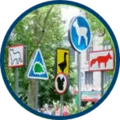
PI: Prof. Dr. Wolfgang Weisser
Affiliated researchers: Dr. Fabio S. T. Sweet, Meret Pundsack, Laura Windorfer
PhD candidate: Zoe Hentschel
Dissertation: Urban Green spaces ad hostspots for Biodiversity
Background: Densification puts pressure on the remaining natural areas within cities, such that fragments of natural habitat shrink, then disappear, and connections between remnant green spaces are lost. Urban biodiversity can be high, yet it is only in the past years that the factors promoting urban biodiversity are beginning to be unravelled. While species richness in cities is positively related to the amount and size of urban green space available, the importance of particular elements of urban green infrastructure for the occurrence of certain species is only beginning to be understood. A recent study published by the research group (Fairbairn et al. 2024, Urban biodiversity is affected by human-designed features of public squares, Nature Cities) showed that the details of how a place in a city is designed strongly influences the number and type of species that occur in this place.
Objectives: In the project, the focus will be on the occurrence of insects in the city. We will advance of our understanding of how particular elements of the urban green infrastructure, for example the occurrence of trees, the presence of bushes underneath trees, but also the built form, are important for the presence of particular species, but also entire insect communities.
Methods: Insects will be sampled at different points in Munich, along various gradients. Sampling of insects will be done using a variety of methods including Malaise traps, but also sweep-netting and other techniques. Species will be identified either using conventional methods or using barcoding molecular and classic methods. Advanced statistical methods will be used to link the occurrence of species to the composition of urban green infrastructures. Where necessary and possible, experiments will be conducted to understand how the occurrence insect species can be increased in the city.
Outlook: The results of the project will provide novel insights into how the urban form can be modified in order to increase wildlife in cities.
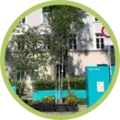
PI: Prof. Dr.-Ing Gebhard Wulfhorst
PhD candidate: Antonia Schauz
Dissertation: Hubs2Stay: the potential of UGI to turn transport nodes into liveable place
Building on the investigations of the importance and influence of UGI on walking and cycling in selected street segments, we will shift the focus in the 2nd cohort on nodes and places.
We wish to take advantage of local amenities to shorten local trips, to shift them towards active modes of walking and cycling and to finally encourage people to “stay”, to enable and increase stationary activities. To “stay” as a free decision for local activities is one of the most sustainable mobility options. By this, we focus on the urban function of transport nodes.
The key objective of this research is to investigate the potential of urban green and blue infrastructure to turn transport nodes into livable urban places.
Potential research questions are:
To which extent can stationary activities take place in the immediate urban surrounding of mobility hubs? What are the consequences on mobility decisions?
How does the urban green and blue infrastructure influence the quality of stay at mobility hubs? Do people feel more comfortable at mobility hubs that are well integrated into the urban environment - what is the role of Urban Green Infrastructure?
What are the consequences on the purpose, the frequency, the duration of stay of stay (e.g. waiting, eating, mobile work, playing, relaxing)? What are the implications with appropriation of space, place-making, mobility behavior?
Methods: Based on literature review and expert interviews, we aim to develop a system model of key variables and interactions (causal-loop diagram) incorporating the transport functions and urban functions of mobility hubs. A diversity of selected sites will enable to conduct comparative empirical investigations such as (participatory) observation, mobility investigations as well as surveys and interviews with users of the hubs about their motivations and experiences in stationary activities at mobility hubs. The results of these investigations will be shared and discussed among the cluster 1 projects, and with the measurements of thermal comfort (e.g. SP7). We will analyze the qualitative and quantitative data in order to identify correlations between UGI effects and user behavior.
Outlook: The findings will be re-integrated into the system model in order to analyze feedback loops that will allow describing the potential of UGI to turn transport nodes into livable urban places, and to derive future scenarios of governance and practice application. Finally, open questions for further research will be addressed.
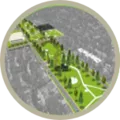
PI: Prof. Dipl. Arch ETH Mark Michaeli
PhD Candidate: Spyridon (Spyros) Nektarios Koulouris
Dissertation: Making Urban Transformation happen. Carrier projects as a synergetic approach to developing urban green-blue infrastructure
Background: Observations on transformatory urban practise show that changes to urban green infrastructure often linked to other investment and upgrading or maintenance cycles of urban infrastructure systems. While the exploitation of these opportunities is widely used practice, the UGI-dimension is often treated secondary or a collateral perspective.
To assure and speed up efficient UGI-transformation a mutual integration of the various transformation perspectives would be required in plans and processes. However, there is only few knowledge about key to successful strategic integration, strategies for priorization or even mixed investment schemes available. As a first step to develop these integrative approaches, the project investigates the conditions for productive linkages and their effects on structural-spatial optimisation processes. (Goal 1). On the basis of these findings, it will be examined whether smart coupling processes can be systematically tapped or accelerated in order to increase the quality of urban green infrastructure (Goal 2)
This project is based on the hypothesis that so-called “carrier projects” (de: “Huckepackprojekte”), namely projects which though potentially following other primary goals also might incorporate the development of and can provide a solution for the aforementioned problematic, thus substantially contributing to advance urban climate adaptation measures. Hansen & Pauleit (2014) and Monteiro et al. (2020) state that the integration of UGI with other urban infrastructures (e.g. transport/water management) is a crucial planning principle of UGI. Similarly, Lennon & Scott (2014) suspecting an “opportunistic” nature of UGI planning often focusing on positive synergies, “recognizing the potential for comparatively non-contributing landscape elements to be managed or structured differently to enhance the assets and functions of a GI network” (Lennon & Scott, 2014, p. 580).
Objectives: The Research Project at SP3 (in conjunction with SP4) aims to scientifically concretize this approach and address the knowledge gap of UGI synergetic implementation strategies by answering the following research questions:
Which kinds of urban projects and transformation processes can incorporate the development of UGI? Accordingly, which types of projects/goals can act as leverage for specific UGI types and ES?
Which are the institutional obstacles or favorable conditions which can inhibit or support these kinds of urban transformations?
How should larger-scale urban strategies be conceived in order to integrate and profit most from the potential of the “carrier project for UGI” approach?
Methods: For (1) descriptive framework will be developed (as suggested for other transformative processes, e.g. Kinigadner et al., 2024), which will be used to typify a large number of reference projects. This will allow us to gather insights into how “carrier project” goals/ characteristics are correlated with specific UGI development and ES provision. This framework will be used to identify typical project constellations and organizational patterns. Based on these patterns, specific case studies will be chosen, whose development and implementation processes will be studied in depth through interviews with involved stakeholders in order to answer question (2). Research work will then be scaled up on a strategic level by analyzing reports on climate adaptation strategies that implement a “carrier” approach (e.g., Rotterdam’s Weerwoord, c.f. Visser et al., n.d.), aiming to address question (3).
Outlook: Through this research process, this project aims to produce operationalizable knowledge which can act as a basis for guidelines to urban governance institutions aiming to better coordinate urban transformation processes and optimize the development of UGI by strategically using suitable projects as “carriers”.
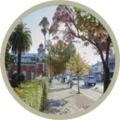
PI: Prof. Dr.-Ing. Stephan Pauleit
Affiliated researchers: Martina van Lierop, Eleanor Chapman
PhD Candidate: Deborah Henschel
Dissertation: The potential of public sector planning for integrated urban green infrastructure development: a network approach.
Background: Urban green infrastructure (UGI) holds great potential to transform cities towards sustainability and climate resilience. Integrative landscape approaches are required to ensure multifunctional use of open spaces addressing biodiversity and climate change as well as health and social cohesion. In densely built inner cities, public open spaces such as streetscapes and squares are a particular target for implementing UGI. Yet, numerous barriers exist to transform these open spaces due to the intensive competition between different functions and uses above and belowground, regulatory barriers and, not least, the diversity of sectoral responsibilities. Although other public sectors have different primary goals, e.g. mobility, they might play a particular role in development of the UGI. However, sectoral approaches can also have drawbacks, such as low social and ecological benefits due to the development of UGI where it is not in need and reinforcing social and environmental injustices.
So far, the focus has been largely on urban planning and open space planning for developing coherent and multifuctional UGI networks through integrative approaches, whereas other public sectors that are responsible for infrastructures such as mobility, water supply, stormwater management, nature conservation, as well as social and health related sectors have been neglected. Therefore, the potential for the development of multifunctional UGI by integrative approaches within and between different sectors is not fully realized. The actual and potential agency of these sectors in UGI development is poorly understood even though some of these sectors, such as mobility planning, may hold considerable potential to drive or hinder UGI. Therefore, a better understanding is needed on whether UGI already is on the agenda of these urban sectors; how they understand the concept of UGI; which actor networks are involved; and which means they can employ to further UGI uptake and implementation. Such understanding can provide insights on how they can contribute to the strategic development of multifunctional UGI. Also, potential drawbacks of such sectoral approaches need to be critically examined.
The objectives are:
To establish the actual consideration of UGI in sectoral planning at different urban scales, and identify barriers and enablers for its uptake in these sectors
To identify good practices of UGI development within and across sectoral planning approaches
To explore the levers for more integrated urban green infrastructure planning and implementation by changing current practices of sector planning and governance modes
With this PhD, we aim to make a step towards integrating different strands of research in our RTG, focusing on: biodiversity, mobility, indoor and outdoor climates, human health, and stormwater management.
The proposed research will include:
A case study of the current role and interactions of different urban sectors to develop UGI, including a network analysis of actors involved, and a review of their understanding of UGI, their UGI-supporting instruments, and the resources employed
A study of good practices in developing UGI within and across sectoral planning
Analysis of transferability of insights gained into urban development processes of the city of Munich as main case study using participatory methods (e.g., workshops, scenario analysis)

Head: Prof. Dr. Ferdinand Ludwig
Affiliated researcher: Xiaohan Zhang
PhD Candidate: Sissy Xi Chen
Dissertation: Designing UGI as a spatio-temporal system
Background: This project emphasizes the importance of considering trees in urban green infrastructure (UGI) through a comprehensive examination of both their design and management. While tree design traditionally focuses on the final, mature state, it often neglects the developmental process (the temporal dimension) leading to that outcome. Few projects have incorporated tree growth as a central aspect of their design concepts. This project takes a different approach by adopting a spatio-temporal system design, where the focus is equally on managing growth processes as it is on the initial planting design.
Objectives: Building on a machine learning-based tree planting model from a previous project, this PhD project addresses the underground environment—an often overlooked factor in tree growth. The lack of understanding regarding how root space impacts tree development creates a critical gap in optimizing planting strategies. The project, therefore, seeks to answer how tree planting locations can be optimized by considering both above- and underground conditions, aiming to achieve growth targets while integrating the temporal dimension into the design process.
The main aims of the project are first to investigate a tree geometry prediction model that accounts for both above- and underground competition by integrating the effects of underground conditions and second to explore a workflow that allows designers to visualize, modify, and optimize design outcomes through an iterative process.
Methods: The research combines machine learning models to predict tree growth with parametric design and optimization within the framework of research by design.
